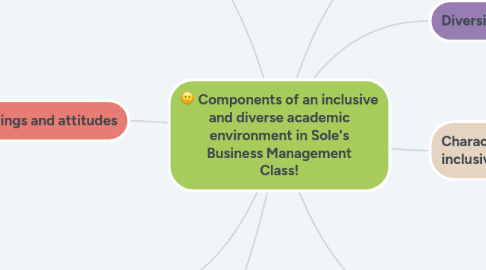
1. Environment design features
1.1. Some design features that allow for inclusiveness and diversity are: desks arranged in groups of 2, 3 or 4; open-door policty; teacher's desk approachable to all; Office Hours availability; clear channels of communication through different tools, such as G-suite: Google chat, Google classrooms.
1.1.1. Desks arranged in groups of 2, 3 or 4
1.1.2. Open-door policy
1.1.3. Teacher's desk approachable to all
1.1.4. Office Hours availability twice a week
1.1.5. Clear channels of communication through different tools: whiteboard, corkboard, Google chat, Google Classroom
2. Impact on feelings and attitudes
2.1. I would like to generate a positive impact on students' and parents' feelings and attitudes towards my classroom and learning in general. In order to do this, I would use the following:
2.1.1. Monthly newsletters to parents to share learning targets and expectations
2.1.2. Welcoming email at the beginning of the year and farewell letter at the end
2.1.3. Congratulatory emails when students have achieved something above and beyond, and concern emails when there are students at risk
2.1.4. Weekly quotes and information on class corkboards
3. Basic teaching elements
3.1. Basic teaching elements of an inclusive and diverse classroom are the following:
3.1.1. Availability of technological tools for everyone
3.1.2. Other materials made available and reachable to everyone
3.1.3. Teacher's modelling of respect and open-mindedness
